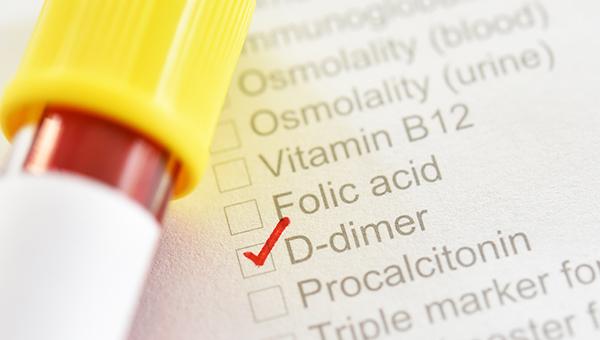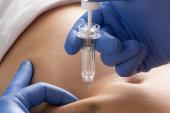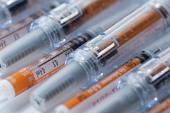HEP-COVID: Therapeutic-Dose Heparin Effective in Non-ICU Patients
D-dimer is an “exquisite” test to pinpoint the COVID-19 patients needing therapeutic anticoagulation, the lead author says.

Patients with high D-dimer levels who are hospitalized with COVID-19—but not those who require ICU-level care—stand to gain a reduction in major thromboembolism and death with therapeutic-dose low molecular weight heparin (LMWH) rather than prophylactic or intermediate doses, according to new data from the HEP-COVID trial.
Abnormal coagulation and multiorgan clotting have been a key component of serious COVID-19 illness, prompting a flurry of studies examining the best agents, doses, and timing for anticoagulation. In one of the largest collaborations to date, investigators for several separate studies, REMAP-CAP, ACTIV-4a, and ATTACC, pooled their efforts in a multiplatform trial confirming a finding hinted at in other studies: that therapeutic-dose heparin is of benefit for noncritically-ill patients but does not have an impact when the disease is more advanced. Figuring out the “sweet spot” for anticoagulation has remained a hot topic in this field.
As such, a key contribution of HEP-COVID, published last week in JAMA Internal Medicine, is that D-dimer is “an exquisite biomarker to predict a very-high-risk population of COVID-19 inpatients,” lead author Alex Spyropoulos, MD (Feinstein Institutes for Medical Research, Manhasset, NY), told TCTMD. Secondly, he continued, the study demonstrates that “especially in the non-ICU settings, D-dimers are not only able to predict a high-risk population, but a population whose risk is modifiable by using therapeutic-dose LMWH.”
Moreover, while the earlier multiplatform trial confirmed that using therapeutic-dose heparin as an add-on treatment strategy could reduce the severity of COVID-19 pneumonia—including acute respiratory distress syndrome (ARDS) and other risky conditions—Spyropoulos said HEP-COVID showed that therapeutic-dose heparin has the potential to reduce macrovessel thromboembolic disease and mortality. “I look at the two trials as complementary,” he observed. “They looked at two separate aspects of the puzzle of COVID coagulopathy.”
The totality of data now “clearly points to the fact that therapeutic-dose heparin, especially LMWH, should be considered the new standard of care globally for inpatient prophylaxis,” Spyropoulos said.
As a result of the HEP-COVID findings, he added, his 23-hospital health system changed its protocol for non-ICU COVID-19 patients “overnight” to indicate therapeutic LMWH dosing as their new standard of care for inpatient thromboprophylaxis in patients with D-dimer levels over two times the upper limit of normal. They will be performing D-dimer measurements at admission and serially for the first 48-72 hours in patients to identify those at, or who may become, high risk.
Fewer Thromboembolic Events
For the trial, Spyropoulos and colleagues randomized 257 patients deemed high risk for thromboembolism and needing supplemental oxygen, 1:1, to either therapeutic-dose enoxaparin (51%) or a standard prophylactic or intermediate dose of LMWH or unfractionated heparin (49%). In all, 249 patients had D-dimer levels four times the upper limit of normal (or a sepsis-induced coagulopathy score of 4 or greater) were included in the analysis. All patients were hospitalized with COVID-19 between May 2020 and May 2021 at one of 12 US centers; 83 of the 249 needed ICU-level care.
Dosing regimens for the standard/intermediate group were according to the local institutions’ standards. For patients randomized to a therapeutic dose, this was given as enoxaparin 1 mg/kg subcutaneous, twice daily if creatinine clearance was 30 mL/min/1.73m2 or greater, and as 0.5 mg/kg twice daily if creatinine clearance was 15-29 mL/min/1.73m2.
Overall, the composite primary efficacy outcome of venous thromboembolism (VTE), arterial thromboembolism (ATE), or all-cause death at 30 days was more likely to occur among patients in the standard/intermediate-dose arm than in those who received therapeutic dosing, a difference driven by a reduction in thromboembolism.
The result was not observed, however, in those receiving ICU-level care. Importantly, there was no difference in the primary safety outcome of major bleeding overall or by ICU status.
Thirty-Day Clinical Outcomes by Heparin Dose
|
|
Therapeutic |
Standard |
RR (95% CI) |
|
VTE, ATE, or Death |
28.7% |
41.9% |
0.68 (0.49-0.96) |
|
Non-ICU |
16.7% |
36.1% |
0.46 (0.27-0.81) |
|
ICU |
51.1% |
55.3% |
0.92 (0.62-1.39) |
|
VTE and ATE |
10.9% |
29.0% |
0.37 (0.21-0.66) |
|
Death |
19.4% |
25.0% |
0.78 (0.49-1.23) |
|
Major Bleeding |
4.7% |
1.6% |
2.88 (0.59-14.02) |
|
Non-ICU |
2.4% |
2.3% |
1.02 (0.15-7.10) |
|
ICU |
8.9% |
0 |
7.62 (0.42-137.03) |
There were also no differences observed in any of the secondary efficacy outcomes, including progression to ARDS, rehospitalization, intubation, extracorporeal membrane oxygenation, or acute kidney injury.
Spyropoulos noted that most of the treatment effect observed with therapeutic-dose heparin related to symptomatic deep vein thrombosis and symptomatic pulmonary embolism, which is “exactly what we would expect.” And while the trial wasn’t powered for mortality, there was a positive trend in that direction with “tantalizing evidence” showing a 22% risk reduction favoring therapeutic-dose LMWH, he said, adding that local investigators deemed about half of the deaths to be cardiovascular. “What that tells me is if this were an adequately powered trial in the thousands, we may have seen a mortality signal,” he commented.
Moreover, even with those higher heparin doses, Spyropoulos said, “you don't really pay a price in terms of harms, and that's the other teaching of HEP-COVID which I think is critical.”
Timing Is Key
The HEP-COVID findings are in-line with other studies showing that timing of anticoagulation is critical for hospitalized COVID-19 patients. “Once they require ICU level of care, the horse is out of the barn. It's simply too late,” Spyropoulos said. “They're well on in their hyperinflammatory state, cytokine storm, and everything else. And it's too late. It's simply too late to engender any treatment effect.”
As for the applicability of intermediate-level heparin dosing, Spyropoulos said the data are clear. Both the multiplatform trial, as well as INSPIRATION, conducted in ICU-level patients, show that intermediate doses are no better than standard in this setting. “If we're going to use this strategy, don't mess around with intermediate dose, go right to therapeutic-dose heparin,” Spyropoulos said. “You don't get as much benefit and you still get some bleed risk, so if you're going to go for it, you've got to go for it.”
In an accompanying editorial, Lana Wahid, MD, and Thomas Ortel, MD, PhD (both Duke University Medical Center, Durham, NC), write that the HEP-COVID findings confirm what was seen in prior research despite some differences in methodology. “These studies help us draw important conclusions concerning the efficacy and safety of anticoagulant therapy in hospitalized patients with COVID-19,” they write.
As for the contrast between noncritically ill patients and those in the ICU, Wahid and Ortel say, “the beneficial effect of therapeutic anticoagulation is diminished and the risk of hemorrhage is increased in patients with progressively more severe disease, potentially related to hyperinflammation, endothelial disruption, platelet activation, and coagulopathy.”
Still, open questions remain.
“The role of antiplatelet therapy remains to be determined as well as other therapies that might modulate the prothrombotic characteristics of SARS-CoV-2 in hospitalized patients,” they conclude. “The distinction between moderate and severe disease can be better defined, specifically when it comes to oxygen requirement. In addition, the transition of patients between the ICU and non-ICU settings represents a time when the intensity of anticoagulant therapy needs to be revisited. Lastly, whether a course of extended anticoagulation following discharge from the hospital, particularly for patients who were hospitalized with a more severe clinical course of COVID-19, or who have persistently elevated D-dimer levels, remains to be determined.”
Spyropoulos said he would like to see future studies home in on both postdischarge and prehospital thromboprophylaxis, as well as what to do more generally for the critically ill patient population.
Commenting on the findings for TCTMD, Menno Huisman, MD, PhD (Leiden University Medical Center, the Netherlands), said the design of HEP-COVID is much more logical than previous studies. “I do not like the multiplatform way of performing trials so much,” he explained. “It gives very mixed results in a very selected population.”
But it’s important to appreciate that HEP-COVID enrolled a highly selected population, Huisman continued. More than 11,000 patients were screened for the trial, but the vast majority were excluded, most because they did not have the requisite D-dimer levels or did not need supplemental oxygen. “That makes this a very special niche population,” Huisman said, noting that the multiplatform trial enrolled a similarly restrictive group. As such, HEP-COVID stands out for “being more representative” of this niche population of high-risk COVID-19 inpatients than those done in the past, he added.
For Huisman, a “straightforward trial in nonselected patients” would be useful, especially in light of how hospital populations are evolving with wider distribution of vaccines. “Is therapeutic heparin better than low or normal-dose prophylactic heparin in COVID patients in the ward? Because we do not have the answer yet,” he said.
Yael L. Maxwell is Senior Medical Journalist for TCTMD and Section Editor of TCTMD's Fellows Forum. She served as the inaugural…
Read Full BioSources
Spyropoulos AC, Goldin M, Giannis D, et al. Efficacy and safety of therapeutic-dose heparin vs standard prophylactic or intermediate-dose heparins for thromboprophylaxis in high-risk hospitalized patients with COVID-19: the HEP-COVID randomized clinical trial. JAMA Intern Med. 2021;Epub ahead of print.
Wahid L, Ortel TL. Anticoagulant therapy in patients hospitalized with COVID-19. JAMA Intern Med. 2021;Epub ahead of print.
Disclosures
- This work was supported by the Feinstein Institutes for Medical Research, the Broxmeyer Fellowship in Clinical Thrombosis, and the National Institute on Aging.
- Spyropoulos reports receiving grants from Janssen and personal fees from Bayer, Bristol Myers Squibb, Boehringer Ingelheim, and The ATLAS Group outside the submitted work.
- Wahid reports receiving National Institutes of Health funding for ACTIV4A and ACTIV4C clinical trials.
- Ortel reports receiving research support from Instrumentation Laboratory, Stago, and Siemens and consulting work from Instrumentation Laboratory outside the submitted work; and receiving National Institutes of Health funding for participating in clinical trials investigating the role of anticoagulant therapy in the management of patients with COVID-19.
- Huisman reports no relative conflicts of interest.





Comments